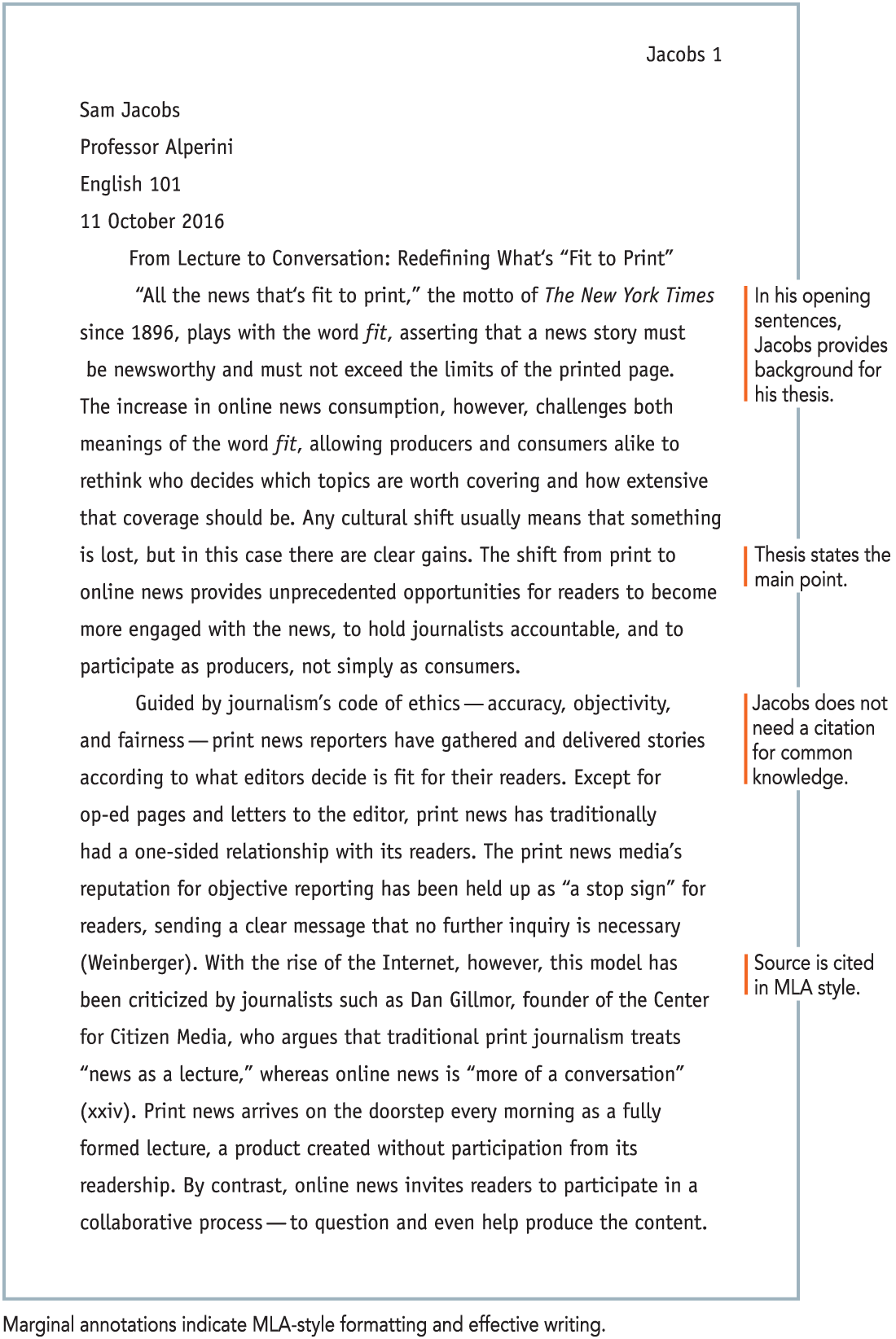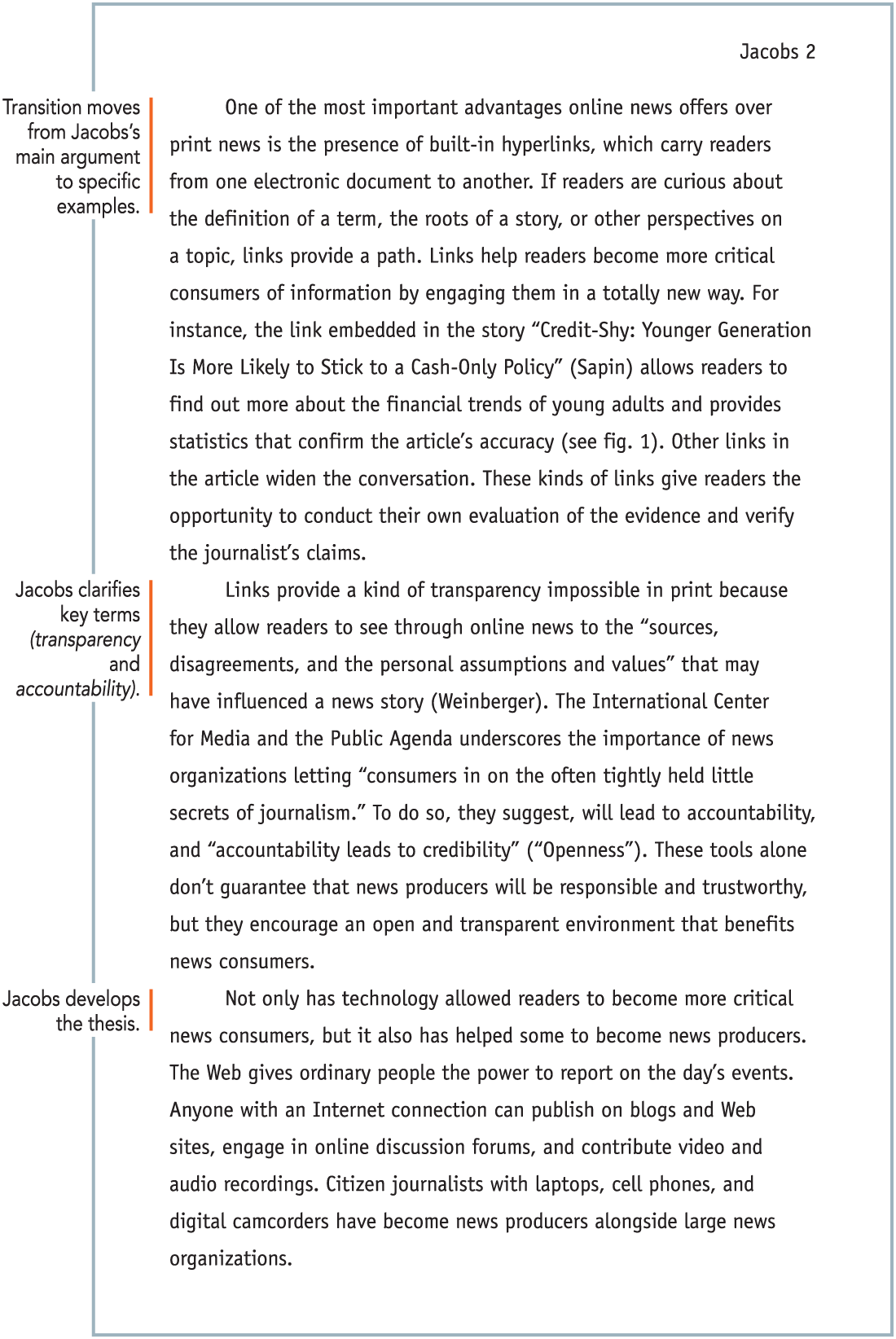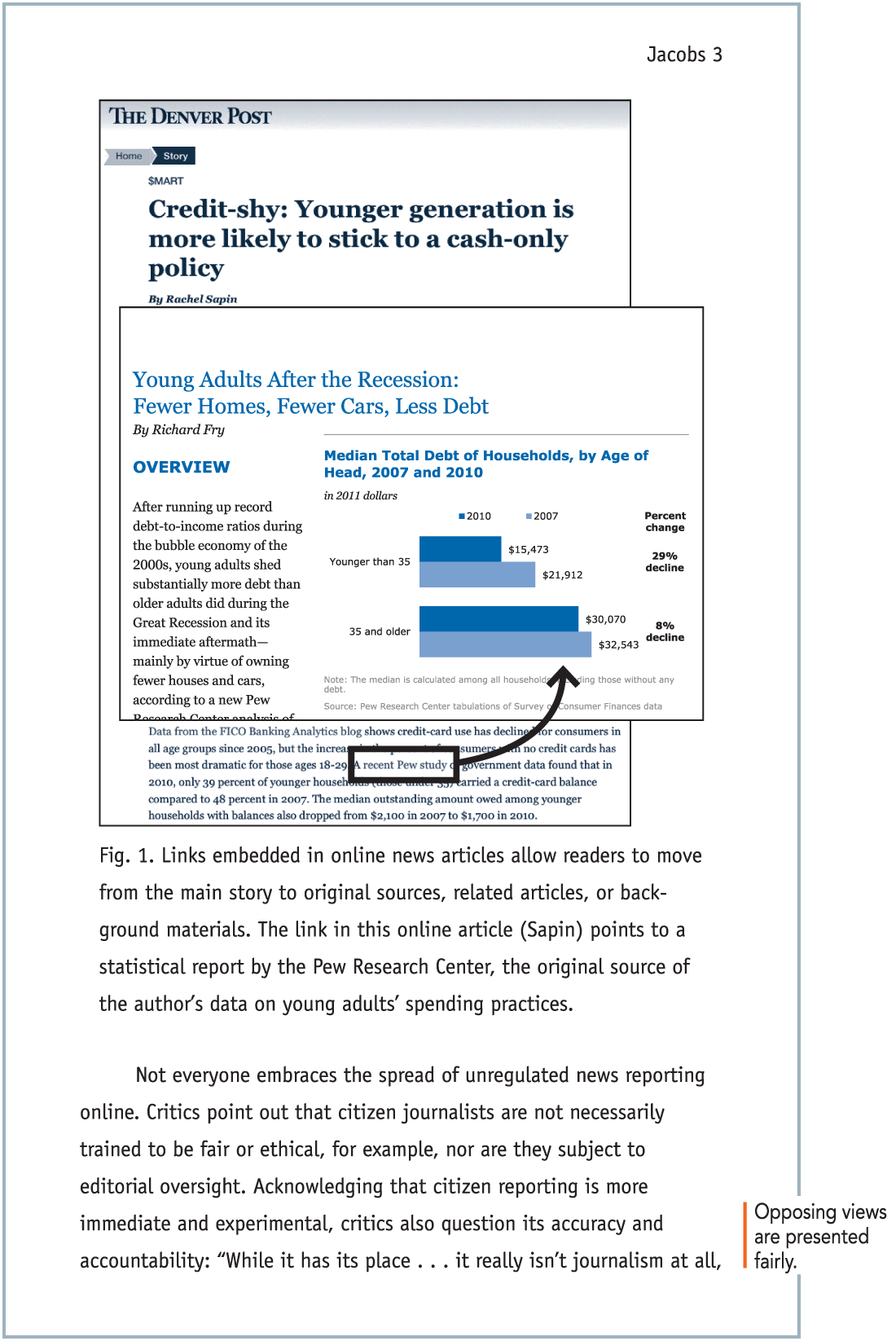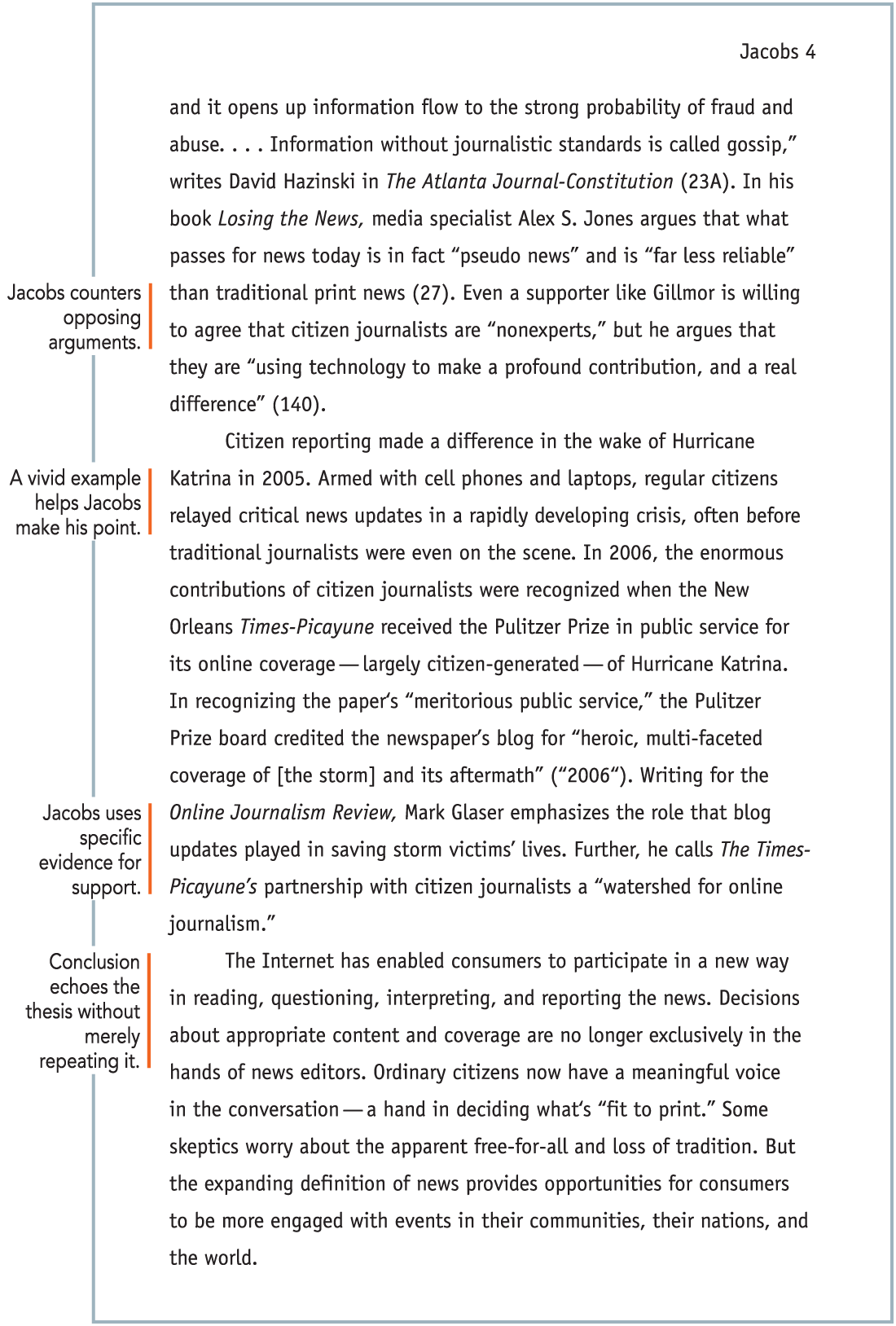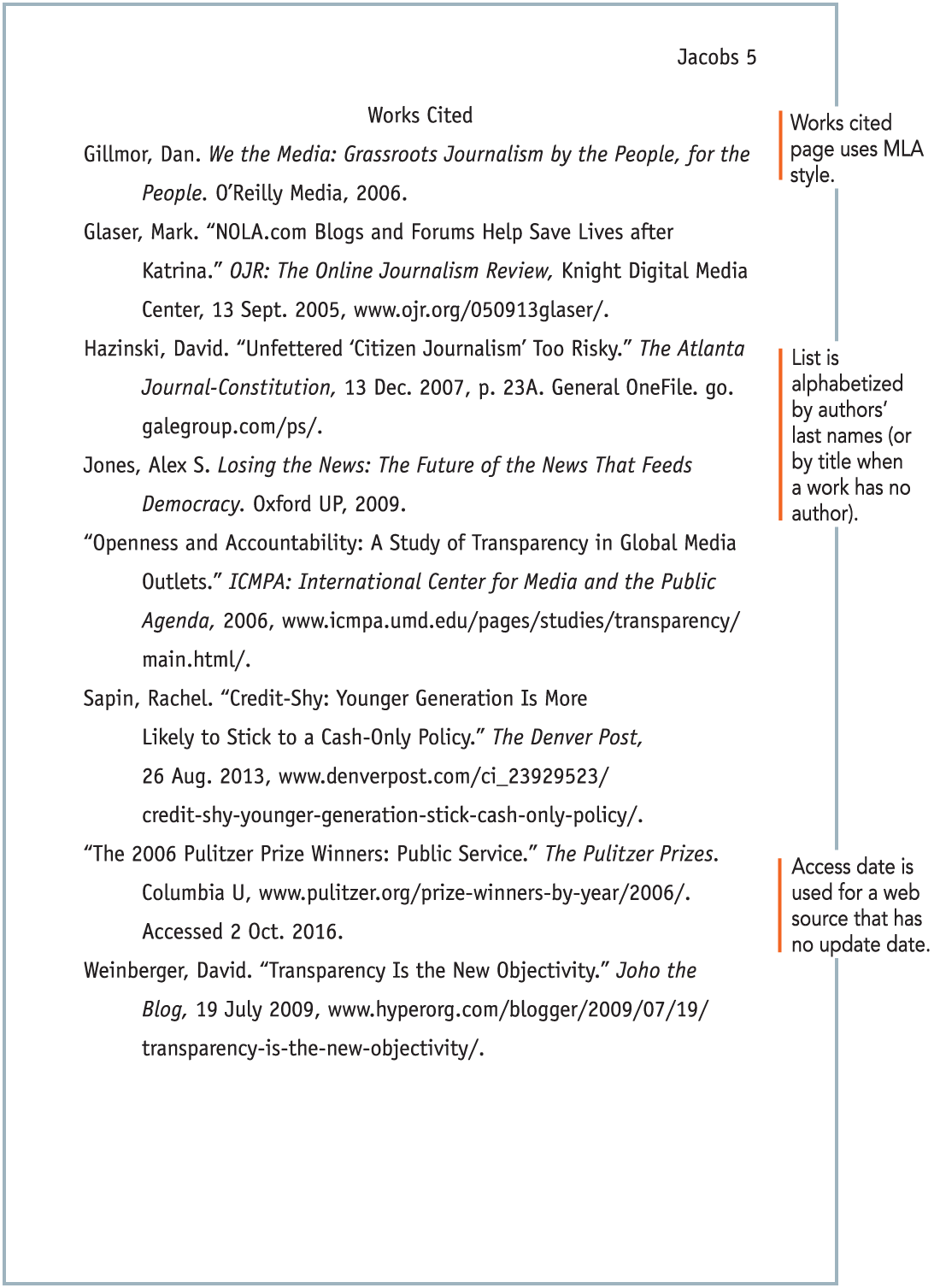6g Sample student writing: ArgumentIn the following paper, student writer Sam Jacobs argues that the shift from print to online news benefits readers by providing them with new opportunities to produce news and to think more critically as consumers of news. Notice how he appeals to his readers by presenting opposing views fairly before providing his own arguments.
When Jacobs quotes, summarizes, or paraphrases information from a source, he cites the source with an in-text citation formatted in MLA style. Citations in the paper refer readers to the list of works cited at the end of the paper. (For more details about citing sources, see section 48 .)
A text on the top right corner of the page reads, Jacobs 1. A text on the top left corner of the page reads, Sam Jacobs, Professor Alperini, English 101, 11 October 2016. The title of the text reads, From Lecture to Conversation: Redefining What‘s open quotes Fit to Print close quotes.
New paragraph. open quotes All the news that‘s fit to print, close quotes the motto of The New York Times since 1896, plays with the word fit, asserting that a news story must be newsworthy and must not exceed the limits of the printed page. [A margin note reads, In his opening sentences, Jacobs provides background for his thesis. End margin note.] The increase in online news consumption, however, challenges both meanings of the word fit, allowing producers and consumers alike to rethink who decides which topics are worth covering and how extensive that coverage should be. Any cultural shift usually means that something is lost, but in this case there are clear gains. The shift from print to online news provides unprecedented opportunities for readers to become more engaged with the news, to hold journalists accountable, and to participate as producers, not simply as consumers. [A margin note reads, Thesis states the main point. End margin note.]
New paragraph. Guided by journalism’s code of ethics m dash accuracy, objectivity, and fairness m dash print news reporters have gathered and delivered stories according to what editors decide is fit for their readers. [A margin note reads, Jacobs does not need a citation for common knowledge. End margin note.] Except for op-ed pages and letters to the editor, print news has traditionally had a one-sided relationship with its readers. The print news media’s reputation for objective reporting has been held up as open quotes a stop sign close quotes for readers, sending a clear message that no further inquiry is necessary (Weinberger). With the rise of the Internet, however, this model has been criticized by journalists such as Dan Gillmor, founder of the Center for Citizen Media, who argues that traditional print journalism treats open quotes news as a lecture, close quotes whereas online news is open quotes more of a conversation close quotes (xxiv). [A margin note reads, Source is cited in M L A style. End margin note.] Print news arrives on the doorstep every morning as a fully formed lecture, a product created without participation from its readership. By contrast, online news invites readers to participate in a collaborative process m dash to question and even help produce the content.
A text on the top right corner of the page reads, Jacobs 2.
The text reads, One of the most important advantages online news offers over print news is the presence of built-in hyperlinks, which carry readers from one electronic document to another. [A margin note reads, Transition moves from Jacobs’s main argument to specific examples. End margin note.] If readers are curious about the definition of a term, the roots of a story, or other perspectives on a topic, links provide a path. Links help readers become more critical consumers of information by engaging them in a totally new way. For instance, the link embedded in the story open quotes Credit-Shy: Younger Generation Is More Likely to Stick to a Cash-Only Policy close quotes (Sapin) allows readers to find out more about the financial trends of young adults and provides statistics that confirm the article’s accuracy (see fig. 1). Other links in the article widen the conversation. These kinds of links give readers the opportunity to conduct their own evaluation of the evidence and verify the journalist’s claims.
New paragraph. Links provide a kind of transparency impossible in print because they allow readers to see through online news to the open quotes sources, disagreements, and the personal assumptions and values close quotes that may have influenced a news story (Weinberger). [A margin note reads, Jacobs clarifies key terms (transparency and accountability). End margin note.]The International Center for Media and the Public Agenda underscores the importance of news organizations letting open quotes consumers in on the often tightly held little secrets of journalism. Close quotes To do so, they suggest, will lead to accountability, and open quotes accountability leads to credibility close quotes (open quotes Openness close quotes). These tools alone don’t guarantee that news producers will be responsible and trustworthy, but they encourage an open and transparent environment that benefits news consumers.
New paragraph. Not only has technology allowed readers to become more critical news consumers, but it also has helped some to become news producers. [A margin note reads, Jacobs develops the thesis. End margin note.] The Web gives ordinary people the power to report on the day’s events. Anyone with an Internet connection can publish on blogs and Web sites, engage in online discussion forums, and contribute video and audio recordings. Citizen journalists with laptops, cell phones, and digital camcorders have become news producers alongside large news organizations.
Screen grabs of online news article overlap each other; one of the articles by Denver post is titled Credit-shy: Younger generation is more likely to stick to a cash-only policy while the other article is titled Young Adults After the Recession: Fewer Homes, Fewer Cars, Less Debt. A horizontal bar graph, beside the overview of the article plots the median of total debt in dollars of household in the years 2007 and 2010, by people belonging to the age group younger than 35 years, and 35 years and older. The graph shows that the debt of households is higher when the age of head is more than 35. A text in Jacob’s article points to the longest bar representing the median of total debt in the years 2007 and 2010, which shows the debt of households of people who are 35 and above.
A text on the top right corner of the page reads, Jacobs 3.
New paragraph. Figure 1. Links embedded in online news articles allow readers to move from the main story to original sources, related articles, or background materials. The link in this online article (Sapin) points to a statistical report by the Pew Research Center, the original source of the author’s data on young adults’ spending practices.
New paragraph. Not everyone embraces the spread of unregulated news reporting online. Critics point out that citizen journalists are not necessarily trained to be fair or ethical, for example, nor are they subject to editorial oversight. Acknowledging that citizen reporting is more immediate and experimental, critics also question its accuracy and accountability: open quotes While it has its place ellipsis it really isn’t journalism at all, [A margin note reads, Opposing views are presented fairly. End margin note.]
A text on the top right corner of the page reads, Jacobs 4.
The text reads, and it opens up information flow to the strong probability of fraud and abuse ellipsis. Information without journalistic standards is called gossip, close quotes writes David Hazinski in The Atlanta Journal-Constitution (23 A). In his book Losing the News, media specialist Alex S. Jones argues that what passes for news today is in fact open quotes pseudo news close quotes and is open quotes far less reliable close quotes than traditional print news (27). Even a supporter like Gillmor is willing to agree that citizen journalists are open quotes nonexperts, close quotes but he argues that they are open quotes using technology to make a profound contribution, and a real difference close quotes (140). [A margin note reads, Jacobs counters opposing arguments. End margin note.]
New paragraph. Citizen reporting made a difference in the wake of Hurricane Katrina in 2005. Armed with cell phones and laptops, regular citizens relayed critical news updates in a rapidly developing crisis, often before traditional journalists were even on the scene. [A margin note reads, A vivid example helps Jacobs make his point. End margin note.] In 2006, the enormous contributions of citizen journalists were recognized when the New Orleans Times-Picayune received the Pulitzer Prize in public service for its online coverage m dash largely citizen-generated m dash of Hurricane Katrina. In recognizing the paper‘s open quotes meritorious public service, close quotes the Pulitzer Prize board credited the newspaper’s blog for open quotes heroic, multi-faceted coverage of [the storm] and its aftermath close quotes (open quotes 2006 close quotes). Writing for the Online Journalism Review, Mark Glaser emphasizes the role that blog updates played in saving storm victims’ lives. Further, he calls The Times- Picayune’s partnership with citizen journalists a open quotes watershed for online journalism. Close quotes [A margin note reads, Jacobs uses specific evidence for support. End margin note.]
New paragraph. The Internet has enabled consumers to participate in a new way in reading, questioning, interpreting, and reporting the news. Decisions about appropriate content and coverage are no longer exclusively in the hands of news editors. Ordinary citizens now have a meaningful voice in the conversation m dash a hand in deciding what‘s open quotes fit to print. Close quotes Some skeptics worry about the apparent free-for-all and loss of tradition. But the expanding definition of news provides opportunities for consumers to be more engaged with events in their communities, their nations, and the world. [A margin note reads, Conclusion echoes the thesis without merely repeating it. End margin note.]
A text on the top right corner of the page reads, Jacobs 5.
New paragraph. Works Cited
New paragraph. Gillmor, Dan. We the Media: Grassroots Journalism by the People, for the People. O’Reilly Media, 2006. [A margin note reads, Works cited page uses M L A style. End margin note.]
New paragraph. Glaser, Mark. Open quotes N O L A dot com Blogs and Forums Help Save Lives after Katrina. Close quotes O J R: The Online Journalism Review, Knight Digital Media Center, 13 September 2005, w w w dot o j r dot o r g/050913glaser/.
New paragraph. Hazinski, David. Open quotes Unfettered ‘Citizen Journalism’ Too Risky. Close quotes The Atlanta Journal-Constitution, 13 December 2007, page 23 A. General OneFile. go.galegroup.com/ps/.
New paragraph. Jones, Alex S. Losing the News: The Future of the News That Feeds Democracy. Oxford U P, 2009.
New paragraph. open quotes Openness and Accountability: A Study of Transparency in Global Media Outlets. Close quotes I C M P A: International Center for Media and the Public Agenda, 2006, w w w dot i c m p a dot u m d dot e d u/pages/studies/transparency/main.html/. [A margin note reads, List is alphabetized by authors’ last names (or by title when a work has no author).]
New paragraph. Sapin, Rachel. Open quotes Credit-Shy: Younger Generation Is More
Likely to Stick to a Cash-Only Policy. Close quotes The Denver Post, 26 August 2013, w w w dot denverpost.com/ci_23929523/credit-shy-younger-generation-stick-cash-only-policy/.
open quotes The 2006 Pulitzer Prize Winners: Public Service. Close quotes The Pulitzer Prizes.
Columbia U, w w w dot Pulitzer dot o r g/prize-winners-by-year/2006/. Accessed 2 October 2016. [A margin note reads, Access date is used for a web source that has no update date. End margin note.]
New paragraph. Weinberger, David. Open quotes Transparency Is the New Objectivity. Close quoes Joho the Blog, 19 July 2009, w w w dot hyperorg dot com/blogger/2009/07/19/transparency-is-the-new-objectivity/.
When you compose an argument , you propose a reasonable solution to a debatable issue. You state your position, provide evidence to support it, and respond to other positions on the issue. A sample argument essay begins in 6g .
A thesis, stated as a clear position on a debatable issue, frames an argument essay. The issue is debatable because reasonable people disagree about it.An examination of the issue’s context indicates why the issue is important, why readers should care about it, or how your position fits into the debates surrounding the topic.Sufficient, representative, and relevant evidence supports the argument’s claims. Evidence needs to be specific and persuasive; quoted, summarized, or paraphrased fairly and accurately; and cited correctly.Opposing positions are summarized and countered. By anticipating and countering objections to your position, you establish common ground with readers and show yourself to be a reasonable and well-informed writer.
Thinking ahead: Presenting or publishing You may have some flexibility in how you present or publish your argument. If you submit your argument as an audio or video essay, make sure you understand the genre’s conventions and think through how your voice or a combination of sounds and images can help you establish your ethos . If you are taking a position on a local issue, consider publishing your argument in the form of a newspaper op-ed or letter to the editor. The benefit? A real-world audience.
Explore
Generate ideas by responding to questions such as the following.
What is the debate around your issue? What sources will help you learn more about your issue?
What position will you take? Why does your position need to be argued?
What evidence supports your position? What evidence makes you question your position?
What types of appeals—ethos , logos , pathos —might you use to persuade readers? How will you build common ground with your readers?
Draft
Try to figure out the best way to structure your argument. A typical approach might include the following steps: capture readers’ attention; state your thesis; give background information; support your major claims with specific evidence; recognize and respond to opposing points of view; and end by reinforcing your thesis and reminding readers why it matters.
As you draft, think about the best order for your claims. You could organize by strength, building up to your strongest argument (instead of starting with your strongest), or by concerns your audience might have.
Revise
Ask your reviewers for specific feedback. Here are some questions to guide their comments.
Is the thesis clear? Is the issue debatable?
Is the evidence persuasive? Is more needed?
Is your argument organized logically?
Are there any flaws in your reasoning or assumptions that weaken the argument?
Have you presented yourself as a knowledgeable, trustworthy writer?
Does the conclusion pull together your entire argument? How might the conclusion be made more effective?
